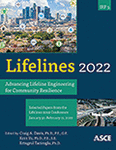Survival Functions of the Shelter-in-Place Households for Disruptions in Infrastructure Services
Publication: Lifelines 2022
ABSTRACT
This paper provides a necessary analysis of community tolerance for prolonged disruptions of infrastructure services due to natural hazards. Currently, little is known about how households are affected by prolonged service disruptions. In this paper, we develop survival models for disruptions in power systems using empirical data collected in the aftermath of three major hurricanes, namely Hurricane Harvey, Hurricane Florence, and Hurricane Michael. Survival analysis was conducted to determine the household’s tolerance for disruptions of infrastructure services. Consequently, survival curves were developed, showing the proportion of households experiencing hardship when the disruptions exceed certain levels. The presented survival models could be adapted in various locations for different services to assist utility companies and involved stakeholders for developing metrics to consider the societal expectation of the infrastructure services. The introduced measures facilitate decision-making by considering service needs of the community, setting priority for restorations, and better communicating risks to service users.
Get full access to this article
View all available purchase options and get full access to this chapter.
REFERENCES
Afroogh, S., Esmalian, A., Donaldson, J., and Mostafavi, A. (2021). “Empathic Design in Engineering Education and Practice: An Approach for Achieving Inclusive and Effective Community Resilience.” Sustainability, 13(7), 4060.
ATC (Applied Technology Council). (2016). “Critical assessment of lifeline system performance: understanding societal needs in disaster recovery.”.
Baker, E. J. (2011). “Household preparedness for the Aftermath of Hurricanes in Florida.” Applied Geography, Elsevier Ltd, 31(1), 46–52.
Barker, K., and Baroud, H. (2014). “Proportional hazards models of infrastructure system recovery.” Reliability Engineering and System Safety, Elsevier, 124, 201–206.
Clark, S. S., Seager, T. P., and Chester, M. V. (2018). “A capabilities approach to the prioritization of critical infrastructure.” Environment Systems and Decisions, Springer US, 0(0), 0.
Coleman, N., Esmalian, A., and Mostafavi, A. (2019). “Equitable Resilience in Infrastructure Systems: Empirical Assessment of Disparities in Hardship Experiences of Vulnerable Populations during Service Disruptions.” Natural Hazards Review.
Coleman, N., Esmalian, A., and Mostafavi, A. (2020). “Anatomy of Susceptibility for Shelter-in-Place Households Facing Infrastructure Service Disruptions Caused by Natural Hazards.” International Journal of Disaster Risk Reduction.
Dale, C. J. (1985). “Application of the proportional hazards model in the reliability field.” Reliability Engineering, 10(1), 1–14.
Douglas, P., and David, J. (2001). “Disasters and communities: vulnerability, resilience and preparedness.” Disaster Prevention and Management: An International Journal, MCB UP Ltd, 10(4), 270–277.
Esmalian, A., Dong, S., Coleman, N., and Mostafavi, A. (2019). “Determinants of risk disparity due to infrastructure service losses in disasters: a household service gap model.” Risk Analysis.
Esmalian, A., Dong, S., and Mostafavi, A. (2020). “Empirical Assessment of Household Susceptibility to Hazards-induced Prolonged Power Outages.” 4(1), 1–5.
Flanagan, B. E., Gregory, E. W., Hallisey, E. J., Heitgerd, J. L., and Lewis, B. (2011). “A Social Vulnerability Index for Disaster Management.” Journal of Homeland Security and Emergency Management.
Fothergill, A., and Peek, L. A. (2004). “Poverty and disasters in the United States: A review of recent sociological findings.” Natural Hazards.
Kessler, R. C., Wang, P. S., Kendrick, D., Lurie, N., and Springgate, B. (2007). “Hurricane Katrina’s impact on the care of survivors with chronic medical conditions.” Journal of General Internal Medicine.
Koks, E. E., Jongman, B., Husby, T. G., and Botzen, W. J. W. (2015). “Combining hazard, exposure and social vulnerability to provide lessons for flood risk management.” Environmental Science and Policy, Elsevier Ltd, 47, 42–52.
Lindell, M. K., Arlikatti, S., and Prater, C. S. (2009). “Why people do what they do to protect against earthquake risk: Perceptions of hazard adjustment attributes.” Risk Analysis, 29(8), 1072–1088.
Lindell, M. K., and Hwang, S. N. (2008). “Households’ perceived personal risk and responses in a multihazard environment.” Risk Analysis, 28(2), 539–556.
Liu, H., Davidson, R. A., and Apanasovich, T. V. (2007). “Statistical forecasting of electric power restoration times in hurricanes and ice storms.” IEEE Transactions on Power Systems, 22(4), 2270–2279.
Marsh, B., Parnell, A. M., and Joyner, A. M. (2010). “Institutionalization of Racial Inequality in Local Political Geographies.” Urban Geography, 31(October 2014), 691–709.
McIvor, D., and Paton, D. (2007). “Preparing for natural hazards: normative and attitudinal influences.” Disaster Prevention and Management: An International Journal, 16(4), 270–277.
Mitsova, D., Esnard, A. M., Sapat, A., and Lai, B. S. (2018). “Socioeconomic vulnerability and electric power restoration timelines in Florida: the case of Hurricane Irma.” Natural Hazards, Springer Netherlands, 94(2), 689–709.
Morss, R. E., Mulder, K. J., Lazo, J. K., and Demuth, J. L. (2016). “How do people perceive, understand, and anticipate responding to flash flood risks and warnings? Results from a public survey in Boulder, Colorado, USA.” Journal of Hydrology, Elsevier B.V., 541, 649–664.
Muttarak, R., and Pothisiri, W. (2012). “The Role of Education on Disaster Preparedness: Case Study of 2012 Indian Ocean Earthquakes and Tsunami Warnings on Thailand’s Andaman Coast Raya Muttarak 1 and Wiraporn Pothisiri 2.” 18(4), 1–30.
NIST. (2015). Community resilience planning guide for buildings and infrastructure systems, Volume II. II, 260.
Oakes, D. (2001). Survival analysis. Statistics in the 21st Century.
Rosenheim, N., Guidotti, R., Gardoni, P., and Peacock, W. G. (2019). “Integration of Detailed Housing Unit Characteristic Data with Critical Infrastructure and Its Implementation to Post-Hazard Resilience Modeling.” Sustainable and Resilient Infrastructure, Taylor & Francis, 00(00), 1–17.
Seyrfar, A., Zandiatashbar, A., and Canepa, A. (n.d.). “Evaluating Transportation Equity: Focusing on Transit Deserts and Transit-Dependent Population.” International Conference on Transportation and Development 2021, 407–417.
Stough, L. M., Sharp, A. N., Resch, A. J., Decker, C., and Wilker, N. (2015). “Barriers to the long-term recovery of individuals with disabilities following a disaster.” Disasters.
Information & Authors
Information
Published In
History
Published online: Nov 16, 2022
Authors
Metrics & Citations
Metrics
Citations
Download citation
If you have the appropriate software installed, you can download article citation data to the citation manager of your choice. Simply select your manager software from the list below and click Download.
